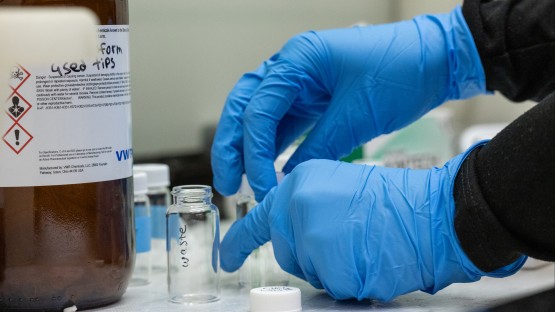Researchers from Cornell and Northwestern universities have developed a rapid, cell-free method for building nanoparticle vaccines that mimic viruses at the molecular level, offering a powerful new tool for responding to emerging pandemics.
By producing and folding full-length viral membrane proteins directly into synthetic lipid bubbles called liposomes, the technique creates vaccine candidates in hours, rather than weeks or months, and could pave the way for faster, more adaptable immunization strategies against deadly viruses like Nipah.
The research, presented in the paper “Cell-Free Expression of Nipah Virus Transmembrane Proteins for Proteoliposome Vaccine Design,” published June 3 in the journal ACS Nano. The co-corresponding authors are Susan Daniel, the William C. Hooey Director of the R.F. Smith School of Chemical and Biomolecular Engineering at Cornell; Hector Aguilar-Carreno, professor of virology in the College of Veterinary Medicine at Cornell; and Neha Kamat, associate professor of biomedical engineering and (by courtesy) chemical and biological engineering at the Northwestern University McCormick School of Engineering.
The study focuses on the Nipah virus, a neurological and respiratory disease with a fatality rate as high as 75% and no currently approved therapies or vaccines. Because of this, the World Health Organization includes Nipah on its list of viruses with pandemic potential. The research team began developing the vaccine during the COVID-19 pandemic, recognizing the need for faster vaccine development methods.
“In a sense, we were lucky with COVID-19 that a lot of research had already been done on coronaviruses, causing leading researchers to have insight into which effective antigens should be delivered in a vaccine,” said Kamat. “But that could easily not be the case for a future epidemic where less is known about a potential virus. We need ways to rapidly assemble and screen vaccine formulations that present the most effective proteins for a given virus.”
Beyond the findings specific to Nipah virus, the platform could be adapted to address a broad range of viral threats or even therapeutic vaccines for cancer. The method’s simplicity and speed make it especially promising for global vaccine access, particularly in areas with limited refrigeration and infrastructure.
The new approach enables vaccine components to be made quickly without live cells, which reduces the time and complexity typically involved in developing traditional vaccines. Cell-free protein synthesis systems contain the molecular machinery from cells but operate in vitro, allowing for protein expression in just a few hours. The system produces membrane proteins that can fold and insert themselves into lipid vesicles without the help of protein chaperones, which are normally required inside living cells.
“By eliminating the need for living cells to produce these vaccine particles, we are no longer constrained by the specific conditions that are needed to maintain those living cells,” Daniel said. “That means we can manufacture these vaccines in simpler conditions and that translates to much faster production times.”
The team’s new method creates tiny fat-based bubbles called liposomes that copy the structure of real viruses. These bubbles display important proteins from the Nipah virus on their surface, which helps the immune system recognize and respond to a potential infection.
In this study, researchers added two key Nipah proteins, NiV F and NiV G, into the liposomes. NiV F helps the virus fuse with host cells, and NiV G helps it attach. To improve how well these proteins were produced and inserted into the liposomes, the team removed a segment from NiV F that normally directs the protein to the right organelle in a living cell, but that is unnecessary when working outside of cells, making it easier to work with.
They also adjusted the types of fats in the liposome, adding ingredients like phosphatidylethanolamine and phosphatidylserine, which made the membrane more flexible and helped the proteins settle in better. These changes led to a stronger immune response.
The researchers also added lipid A, an ingredient that helps boost the immune response, to the liposome mix. Mice that received liposomes with both viral proteins and lipid A produced more antibodies than those that got simpler versions. Among the two proteins tested, NiV G triggered a stronger immune response, making it the more dominant one.
“The beauty of this system and formulation approach is that we can create vaccine particles tailored with specific components that allow us to test the impact of each component on the immune response,” Daniel said. “This tailorability means we can produce vaccine particles optimized for the best performance while learning what components contribute to that success.”
The research was supported in part by the National Science Foundation, the McCormick Research Catalyst Program, and the National Institutes of Health.
This article was adapted with permission from a version published by Brian Sandalow at Northwestern University.
